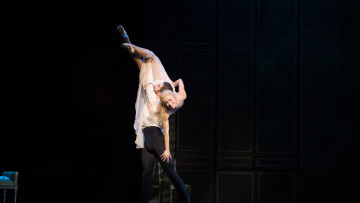Bringing Études to the stage

With opening night just one week away, the energy in the Queensland Ballet studios has been electric. The long journey to Études has been a challenging yet rewarding one, and this will be illustrated once the dancers take the stage.
When you watch a performance of Harald Lander’s Études, it’s as though you are catching a glimpse of a professional ballet company doing ballet class. The dancers start at the barre, where they warm up their legs and feet with a sequence of tendus, grand battements, and fondus. They then progress to the centre, and put on a display of magnificent leaps, pirouettes, and partnering.
But unlike the intimacy of the ballet studio, Études is performed onstage to a mass audience. As a dancer, all eyes are on you, and there is no room for error.
“In our daily class, we practice steps over and over to make them as brilliant as possible. But with Études, you get one opportunity to make it essentially perfect,” says Queensland Ballet Senior Soloist Vito Bernasconi.
The one-act ballet takes simple ballet steps, and illustrates how they can be transformed into art. It is made up of 20 ‘segments’, each representing a different exercise that dancers regularly practice during class.
“Études pays homage to the progression of class, from Barre to Grand Allegro, with an interlude of a Sylph inspired dance, to demonstrate the link between class and historic repertoire,” explains Queensland Ballet’s Ballet Master and former Principal Artist Matthew Lawrence.
Études, which translates to ‘studies’, was originally composed by Austrian composer Carl Czerny, and was a musical piece that was taught to piano students when studying the instrument. Knudåge Riisager, a Danish composer, approached Harald Lander with a version of the piece orchestrated specifically for ballet. Lander was inspired, and created Études choreography on the Royal Danish Ballet, with it first premiering on the 15th of January 1948. Études soon brought Lander international fame, and he continued to make further adaptions, each time making the ballet more complex.
“I find Études particularly hard as there is no storyline, and the story is often what helps me to get through a ballet. There is really nowhere to hide in the choreography, it is as true to classical as you can get!” explains Senior Soloist Mia Heathcote.
The ballet is stylistically based on the Bournoville technique, which focuses on executing each movement with a quality of effortless expression and harmony. This technique, in partnership with a sense of spirit and camaraderie, are all factors a ballet company must possess when performing Études.
All these complex elements that make up Études may make it sound quite daunting, but when Queensland Ballet performs it as part of its 60th Anniversary Gala, it will be a true representation of how the Company has grown and matured over the last 12 months.
The dancers began rehearsing the ballet at the start of last year in anticipation for the 2020 season. The production was polished and the dancers were ready for the stage, but just weeks before opening night, the entire season was postponed due to the COVID-19 pandemic.
Despite the circumstances, the Company took this obstacle in their stride. They approached 2021 with newfound enthusiasm and have spent the last few months perfecting Études to a world-class standard.
“After 12 long months, and with renewed vigour, maturity and insight into this ballet... I am tremendously excited to be performing again!” says Bernasconi.
“Having the opportunity to revisit last year’s season in 2021 after a such a long break from performing has given us the opportunity to start fresh, and get back onstage with new perspectives,” adds Principal Artist Victor Estévez.
Although the dancers were able to pick up on the choreography where they left off, it was a challenge to get their bodies back to a performance-ready standard.
“The technicality required [of Études] is challenging and having not performed in the same type of intensity for a long period, it was quite a physical challenge to get back to the peak condition we were at this time last year,” says Heathcote.
But Ballet Master Matthew Lawrence says it has been rewarding to watch the dancers rise to the occasion and rehearse Études to an even higher standard than before.
“In fact, I think the COVID-19 break has even strengthened some of the dancers.”
In anticipation of opening night, this prolonged rehearsal period has allowed the dancers to explore new avenues of their own technique, including their strengths and weaknesses as performers.
“While playing one of the Lead Principal roles, I have discovered it’s a combination of how refined your class work has to be, while adding the right approach in the Danish style of dancing, musicality and the attention to the quality of the foot work,” says Estévez.
“During this rehearsal period, there has been a prominent focus on mastery of my craft; making each step and movement flow and seem as effortless as possible to the audience, when in reality it may not be,” Says Bernasconi.
With opening night just one week away, the energy in the Queensland Ballet studios has been electric. The long journey to Études has been a challenging yet rewarding one, and this will be illustrated once the dancers take the stage.
“What I most love about performing Études is the powerful energy and the commitment from all the dancers. That energy passes on to me as one of the Lead Principals, connecting us all together to achieve the same goal,” says Estévez.
Queensland Ballet’s 60th Anniversary Gala opens on the 5th of March at QPAC Playhouse. For more information, visit https://www.queenslandballet.com.au/2021/60th-anniversary-gala
Image: Mia Heathcote and the Company rehearse Études. Photographed by Tamara Hanton.
#Related

Media
Passion Unleashed: Dangerous Liaisons Opens at the Thomas Dixon Centre
Extra Performances Added


